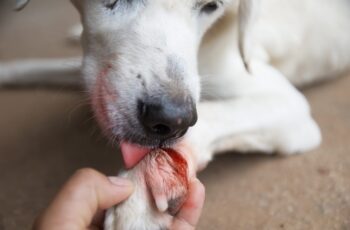
Credit: CriDam | Getty Images
Your dogs were out in the yard, and you call them in. One is limping on her front leg. It’s Saturday night, and you’d like to avoid a visit to the emergency clinic. Luckily, the odds are in your favor. Your dog’s pain may be from something simple, like a sprained front paw.
Usually, acute (sudden onset) lameness is a minor problem. Toe injuries on your dog’s paw are especially common.
What to Do for a Sore Dog at Home
Start by calmly examining your dog’s good leg. Yes, the good one. You know that leg doesn’t hurt, which gives you a comparison for when you get to the injured leg. If your dog is not comfortable bearing weight on the injured leg, have her lie down. Once the sound leg is examined, move on to examine the sore leg.
Carefully palpate the leg, gently flexing and extending each joint. A sprained toe or paw usually results in a “yipe” from your dog. A few dogs might snap, so be careful, while a stoic dog may simply change her breathing.
Check each toe carefully and feel between the toes and between the paw pads. Look at the paw pads for cuts and scrapes. Check to be sure nothing is stuck in the pad. Make sure the dog doesn’t have a broken or cracked nail, which can be very painful.
As you go up the leg, feel for warmth and swelling. Remember, you have a good leg to compare to, so use it! Follow the same procedure if it is a back leg that is lame and sore.
If there is a wound, flush that out thoroughly with clean water. Once clean, you can apply some antibiotic ointment (yes, you can use the family’s generic triple antibiotic ointment on your dog). If it is a large wound that might require sutures, won’t stop bleeding, or it is from a wild animal, you need to call your veterinarian. Antibiotics and possibly a rabies booster shot may be in order. Note: Be very careful if the wound may be due to a tangle with a wild animal. Contact with saliva from an infected animal can infect you with rabies.
Home Treatment for Sore Dog Leg
In most cases, the dog has a pulled muscle. My immediate home treatment is to run a cold hose over the injured leg for five minutes. You must time the five minutes, however, because after 30 seconds or so, it feels like an hour! If you have a helper, one of you can hold your dog’s head while the other hoses the leg.
If it is winter or you don’t have a hose available, put your dog in the shower or bathtub and use a handheld shower head. If no good options are available, place a cold compress on the area where you feel any resistance from your dog. You can use a bag of frozen veggies or put ice in a plastic bag. Keep it there until the area feels cold (maybe five minutes or so). You can always repeat the treatment later.
I prefer running water, if possible, because it massages the leg as it runs down and it stays cold. I repeat the cold-water treatment in eight to 12 hours. In my experience, about 90% acute lamenesses are better by the next morning. That said, even if the dog seems 100% better, restrict exercise for a few days. Call your veterinarian if you feel an anti-inflammatory or pain medication is warranted.
Broken Bones
None of the advice above applies if your dog has a broken leg. In that case, you need to head directly to your veterinarian or an emergency clinic. Keep your dog as quiet as possible. If you face a long drive, you may try to gently splint the leg with rolled up newspapers or magazines around the leg and taped together. The inner cardboard roll from paper towels or wrapping paper can also work. In most cases, you are best off simply confining the dog on soft bedding and hustling to the clinic.


